If you’re not a fan of the famously harsh Canadian cold weather, Victoria, BC is the place for you with an average winter afternoon temperature of over 7 degrees Celsius. And if you love the heat and want hot-hot summers, Kamloops tops our list for the warmest city in the sweltering summer months.
Key Takeaways
- The warmest city in Canada during the winter is Victoria, British Columbia with an average winter afternoon temperature of 7 degrees.
- The top 5 warmest cities in Canada are Victoria, Nanaimo, Vancouver, Abbotsford, and Chilliwack – all in British Columbia.
Never miss an amazing deal again + get our bonus 250+ page eBook for FREE. Join 50,000 other Canadians who receive our weekly newsletter – learn more.
10 warmest cities in Canada in the winter
If you love Canada but not Canadian winters, you might be keen to move to one of the cities with the highest average temperatures in the winter.
| City | Mean winter afternoon temperature (rounded) (2024) |
|---|---|
| Victoria, BC | 7.4°C |
| Nanaimo, BC | 6.9°C |
| Vancouver, BC | 6.8°C |
| Abbotsford, BC | 6.7°C |
| Chilliwack, BC | 6.5°C |
| Kelowna, BC | 1.2°C |
| Kamloops, BC | 1.0°C |
| Halifax, NS | 0.7°C |
| St Catharines, ON | 0.7°C |
| Windsor, ON | 0.5°C |
1. Victoria, BC
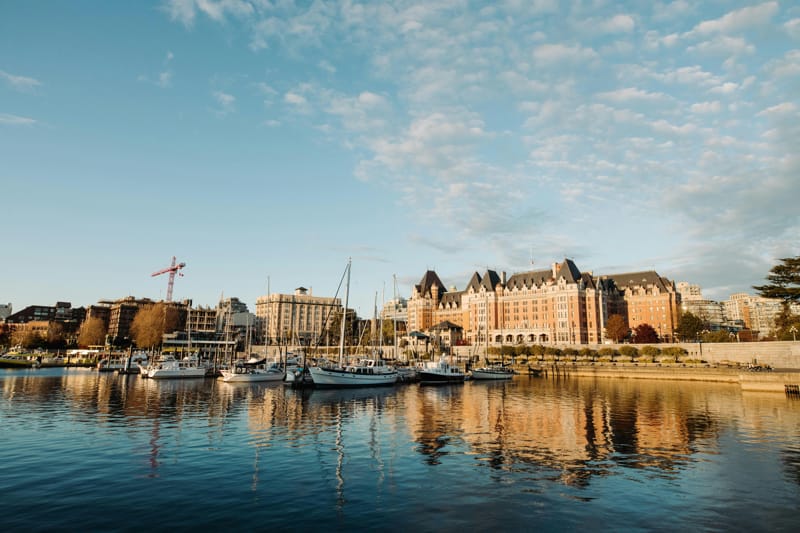
Photo Credit to Armon Arani
BC’s capital city boasts the warmest winter temperature in the country, sitting at an average of 7.4°C this past winter. You’ll enjoy minimal snowfall – the city has only gotten an average of 38.7 cm of snow each winter over the past 10 years of data – and you’ll have the bonus of seeing palm trees all year.
But warmer winters also mean rainy winters. The maritime climate delivers mild temps and plenty of precipitation throughout the winter season before rewarding residents with sunny, dry summers.
2. Nanaimo, BC
Second on our list is the beautiful ferry port city, Nanaimo. Located on the east side of Vancouver Island, it’s no wonder why Nanaimo places so high on our list. The city boasted an afternoon average of 6.9°C this past winter, with minimal snowfall. The maximum yearly average for snowfall in Nanaimo has been around 20 cm since 1975.
Nanaimo experiences unusually dry summers due to the mountains towards the island's center. So, you can look forward to that during those short, dark, rainy winter days.
3. Vancouver, BC
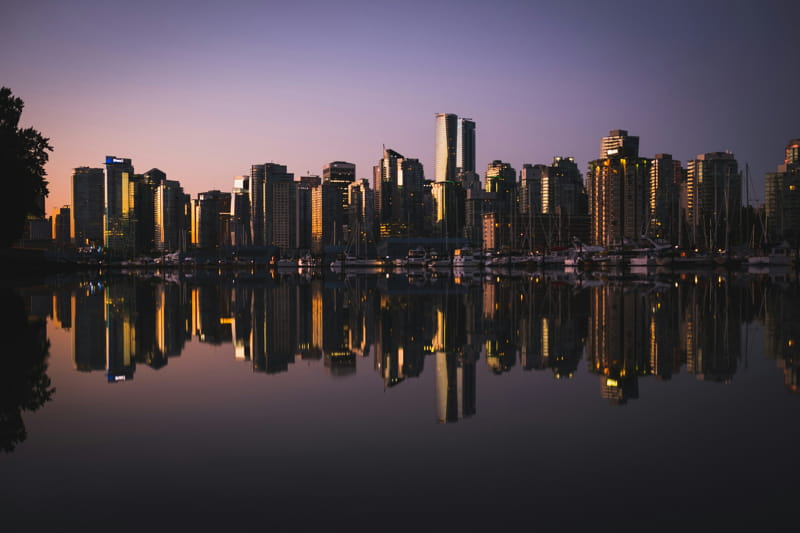
Photo credit to Spencer Watson
Vancouver is probably the city many expected to be #1 – and it’s so close. The winters are mild and the summers are getting warmer thanks to a moderate oceanic climate, which places Vancouver higher on the list. Its overall climate is best described as mild, with both reasonably warm winters (an average of 6.8°C) and cooler summers on average.
Vancouver is also one of the wettest cities on this list. While it doesn’t see much snowfall through the winter, it gets an average annual precipitation exceeding 1,100 mm as of 2020. This rainfall, combined with its warmer climate, leads to a long growing season of around 237 days!
4. Abbotsford, BC
Nestled between the Canada-US border, Greater Vancouver, and the Fraser River is the fifth-largest municipality in British Columbia: Abbotsford. Much like Vancouver, Abbotsford also boasts an oceanic climate with enough rainfall in the summer to be classified as a warm-summer Mediterranean climate.
Unlike Vancouver, however, snowfall (and rainfall) can get pretty heavy in Abbotsford. While some areas in Canada might snort at this, Abbotsford can see a healthy annual average snowfall growing to more than 50 cm. Given its location geographically, it tops the other areas nearby in terms of snowfall. Its average winter temperature, though, is still a pleasant 6.7°C.
5. Chilliwack, BC
Further inland, towards the easternmost end of the Fraser Valley, is Chilliwack, BC. In recent years, Chilliwack has been slammed with heatwaves, with its highest ever recorded temperature recorded during the 2021 Western North America Heatwave when it reached a high of 43.7 Celsius.
Despite its distance from the ocean, the mountains shield Chilliwack from heavy snowfall. Therefore, it gets around the same amount of rainfall you expect from areas around the Strait of Georgia (Nanaimo, Vancouver) and enjoys an average winter temperature of 6.45°C.
All that said, Chilliwack is best known for its air quality. It averaged third best in the world during the 2011 World Health Organization’s air quality study worldwide!
6. Kelowna, BC
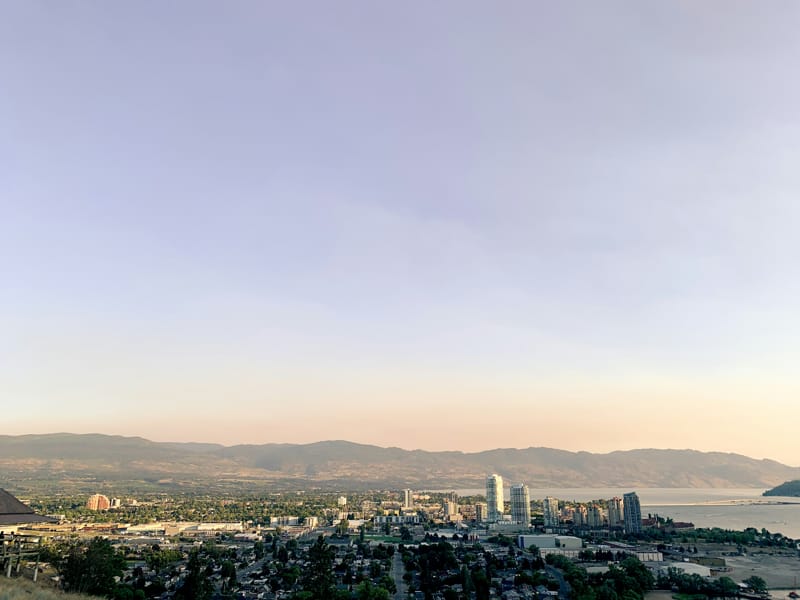
Photo credit to Kolby Milton
Settled 9,000 years ago, the Okanagan Valley area – specifically Kelowna – is well known for its beautiful climate. Kelowna sits on a lake that hasn’t completely frozen over since 1969, and is one of the warmest non-coastal cities in Canada. This is due to the protection of the mountains, although even those can’t stop the occasional Arctic air mass. That said, the cold never stays long in Kelowna.
Kelowna’s position in the mountains, combined with the lake effect, tends to give it a persistently cloudy December and January with temps averaging 1.2°C. But the clouds hang relatively low, and driving up into the mountains can give you much-needed sunshine.
7. Kamloops, BC
Sunny Kamloops, BC, is well known for its semi-arid climate. Its mild winters (1.0°C on average) and lack of rainfall classify it as a semi-desert climate! Despite this, Kamloops will get the occasional (short-lived) cold snap when Arctic air does manage to penetrate the Rockies protecting it.
Kamloops’ climate, however, does make it home to some distinctive, rare, and at-risk plant species. Within Kamloops’ surrounding grasslands, you can find rare sunflowers, lilies, roses, beans, and mustards. If you’re in the area, watch for Chocolate Lily!
8. Halifax, NS
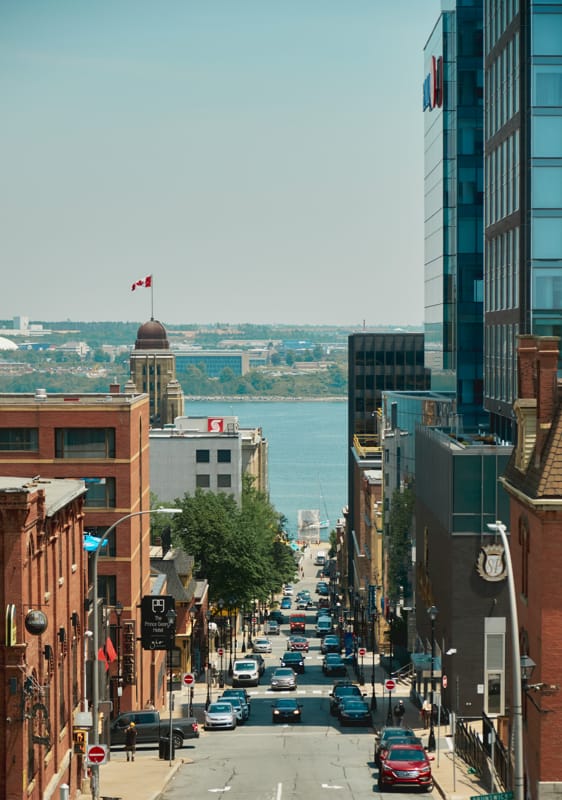
Photo credit to snap shoot
Known for relatively mild winters averaging 0.7°C, Halifax, NS is known for its decent temperatures and year-round precipitation. January is Halifax’s coldest month of the year – but it is the only month in the year where its average temperate high is slightly below freezing.
The Gulf Stream tends to moderate the climate in this area, making its winters a mix of freezing rain and snow with persistent freeze-thaw cycles. This means that although its overall snowfall may be high, it is usually patchy owing to its freeze-thaw cycles.
9. St Catharines, ON
St Catharines is the most populous city in the Niagara region of Southern Ontario and among the top 10 largest urban areas in the province. Its unique micro-climate is humid continental, owing to the influence of Lake Ontario and Lake Erie and the Niagara escarpment to the south.
While the temperatures might be moderate (averaging 0.7°C in the winter), St Catharines gets some frost-free days and frequent thaws in the winter. Under certain conditions, though, the city can get some heavy lake-effect snow.
10. Windsor, ON
Windsor is almost as far south as it gets in Canada (at least among major cities), across a river from Detroit. Like St Catharines, Windsor’s climate is also categorized as humid continental – but its winters can get relatively cold (averaging 0.5°C) and snowy compared to other cities on this list.
Cold snaps leading to dangerous wind chills are infrequent, but they do happen here. On average, you can expect snow for about 46 days of the year!
10 warmest cities in Canada in the summer
If you love summer heat, you’ll probably love the top 10 warmest cities on our list.
| City | Average summer afternoon temp (rounded) (2024) |
|---|---|
| Kamloops, BC | 26.9°C |
| Windsor, ON | 26.6°C |
| Kelowna, BC | 26.3°C |
| Medicine Hat, AB | 25.8°C |
| St Catharines, ON | 25.8°C |
| Brantford, ON | 25.7°C |
| Toronto, ON | 25.4°C |
| Saint-Hyacinthe, QC | 25.2°C |
| Belleville, ON | 25.2°C |
| London, ON | 25.1°C |
1. Kamloops, BC
It’s no surprise that Kamloops, with its semi-desert climate, would place highest on our summer list. Heat waves have slammed Kamloops in recent years, with a recorded high of 47.3 Celsius during the 2021 Western North America heat wave.
Kamloops, BC is known as the "Tournament Capital of Canada." The city offers a wide range of activities and experiences during the summer months, with plenty of festivals to go along with it.
2. Windsor, ON
Windsor’s summers are hot and humid, with an average summer temperature of around 26.6 Celsius. The humidex in this area can make the heat feel particularly oppressive, and you can expect it to feel five or ten degrees hotter than the forecast.
Windsor has the highest number of days per year with lightning and haze and is also known for tornadic activity. The intensity of the weather here can be incredible to see, but you’ll want to be prepared for it.
3. Kelowna, BC
Kelowna, BC, is well known for its sunny weather during the summer. Despite the heat, the city truly shines, as Kelowna offers many outdoor activities and local attractions during the summer. The area also has tons of wineries and festivals to take advantage of.
While it can get quite hot, Kelowna and its surrounding region can get over 2,000 hours of sunshine yearly. It might have cloudy winters but you can expect to make up for it in the summer!
4. Medicine Hat, AB
Sitting along the South Saskatchewan River, Medicine Hat may be a surprise to see on the list. Typically, Alberta is known for its cold climate, but Medicine Hat is the exception with an average summer temperature of 25.8 Celsius. It’s located in the steppe region and has a semi-arid climate, resulting in cold winters and hot, dry summers.
While Medicine Hat may be hot, it isn’t humid and the evening cools it off considerably. It receives less rainfall than pretty much any other city in the Canadian Prairies and is known as the sunniest city in Canada.
5. St Catharines, ON
We mentioned St Catharines above for its mild winters, but it’s also well known for summers averaging 25.8°C. Nestled among the Great Lakes, it’s one of the several cities impacted by humid summers – and some mild thunderstorms.
St Catharines is a popular destination for the summer owing to its wineries, historical attractions, and wealth of festivals. It also has a year-round Farmer’s Market that explodes in activity during the summer months.
6. Brantford, ON
With its rich history and growing cultural scene, Brantford experiences a classic Southern Ontario summer marked by warm (avg. 25.7°C) and humid weather. Like the other Ontario cities on this list, Brantford can experience the occasional heat wave, though nights tend to cool things down in the city.
Brantford has a rich outdoor scene. It sits on the Grand River, which runs through the heart of the town, where kayakers and canoeists can enjoy the river. The 150-acre Brant Conservation Area offers many hiking, fishing, and wildlife viewing experiences.
Did you know? Brantford is known as the ‘Telephone City’ due to its connection to Alexander Graham Bell, who invented the telephone while living there in 1876.
7. Toronto, ON
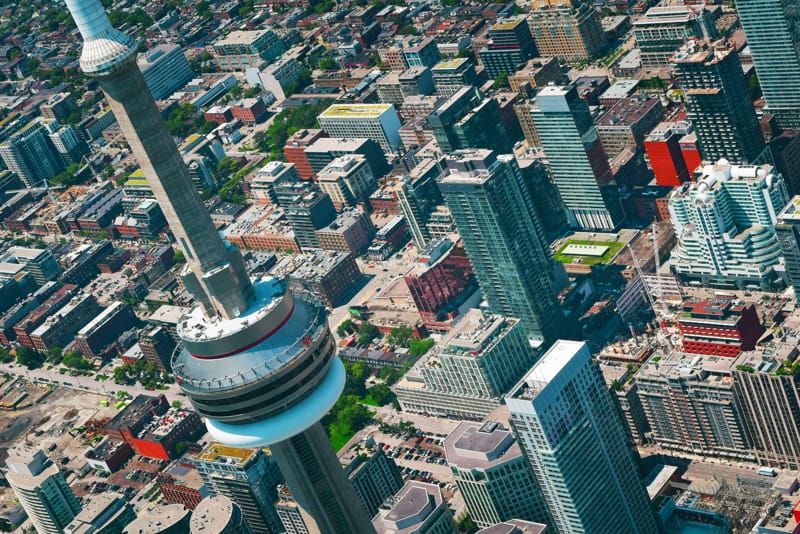
Photo credit to Tim Gouw
Toronto is the most populous city in Canada and the capital of Ontario. It sits on Lake Ontario and has a humid, hot summer climate with an average temperature of 25.4°C. Where other cities on this list tend to cool at night, Toronto’s dense urban landscape keeps things pretty warm during the summer. That said, the lake breeze can sometimes help keep things cool – though it often brings along fog.
Toronto has tons of things to see and do during the summer. Leaving out some of the more obvious choices (like a trip to the CN Tower or one of its historic markets), you can enjoy the summer weather with a visit to the Toronto Islands or High Park. Toronto has several sandy beaches to enjoy!
8. Saint-Hyacinthe, QC
A charming city known for its mix of rural beauty, agricultural heritage, and cultural experiences, Saint-Hyacinthe, Quebec is located in the Montérégie region of the province. You can expect some lovely, warm summers with cooler evenings. Generally, summers are sunny and dry with temps averaging 25.2°C and the occasional rain shower.
Saint-Hyacinthe is in the heart of Quebec’s agricultural region and has agriculture tours, food festivals, and a massive farmer’s market. The summer has plenty of festivals and cultural events, including the Festival de la Saint-Jean-Baptiste in June, which has everything you could want from a summer festival – including fireworks!
9. Belleville, ON
Another Southern Ontario city, Belleville, sits at the eastern end of Lake Ontario at the mouth of the Moira River on the Bay of Quinte. Lake Ontario moderates its temperature, keeping its summers hot and humid (25.2°C, on average) and its winters cold. The snow is limited here, as its precipitation tends to be mainly rainfall – even through winter.
The rainfall ebbs in the summer and you can expect the occasional passing thunderstorm or warm front. The weather won’t stop you from enjoying Belleville’s most popular activities: water sports, boating, cycling, and swimming at the beach.
10. London, ON
London, Ontario, sits right on the confluence of the Thames and North Thames River. It’s around 200 km away from Toronto and Detroit on either side. It’s another Southern Ontario city, so you can probably guess – humid, warm summers and cold, snowy winters.
The convergence of breezes off Lake Huron and Lake Erie heavily affects London's climate. It sits in a convergence zone known for spawning funnel clouds and the occasional tornado. This tornadic activity has risen recently, as London tends to get hotter yearly. The average last year was around 25.1°C.
5 coldest cities in Canada in the winter
On the flip side, what are the coldest cities in Canada? Here are the top 5 cities with the coldest winters you can get in Canada. In short, if you like the heat, these places should be avoided!
Please note our listing does include the territories.
| City | Average winter night-time temperature (rounded) (2024) |
|---|---|
| Fort McMurray, AB | -21.7°C |
| Brandon, MB | -20.9°C |
| Winnipeg, MB | -20.2°C |
| Saskatoon, SK | -19.9°C |
| Saguenay, QC | -19.3°C |
How we got our data
First, we defined "cities" as urban areas with a cut-off population of 50,000. Secondly, we checked out the data from WeatherStats, which uses data collected from Environment Canada and CWOB (Citizen Weather Observer Program) to get the most up-to-date temperature information we could. Our information is current as of November 15, 2024.
Using our definition of cities, we crossed off smaller towns, villages, cities with less than 50,000 people in them, and reserves from our lists. This led us to the cities mentioned above.
FAQ
What part of Canada has the best weather?
Like a parent picking their favorite child, there’s no way we can answer this (but it’s British Columbia).
Which province in Canada is hot?
British Columbia’s interior typically tops the list for the hottest place in the summer and the island for the warmest place in the winter. But warm summers can be found across the country depending on your lifestyle preferences.
Is anywhere in Canada warm year-round?
Southern Vancouver Island is the least cold place in Canada throughout the year. But warm is relative – if you’re looking for temps in the 20s, you won’t find them year-round in Canada.
What’s the sunniest city in Canada?
If you’re looking for the sunniest city in Canada, head to Calgary, which clocks an average of 2,396 hours of sunshine a year – more than any other city in Canada.
creditcardGenius is the only tool that compares 126+ features of 231 Canadian credit cards using math-based ratings and rankings that respond to your needs, instantly. Take our quiz and see which of Canada's 231 cards is for you.






 GC:
GC: 














.png)





















 $100 GeniusCash + Earn up to 15,000 Welcome Bonus Membership Rewards® Points.*
$100 GeniusCash + Earn up to 15,000 Welcome Bonus Membership Rewards® Points.*
Comments
Leave a comment
Required fields are marked with *. Your email address will not be published.
Showing 1 comments